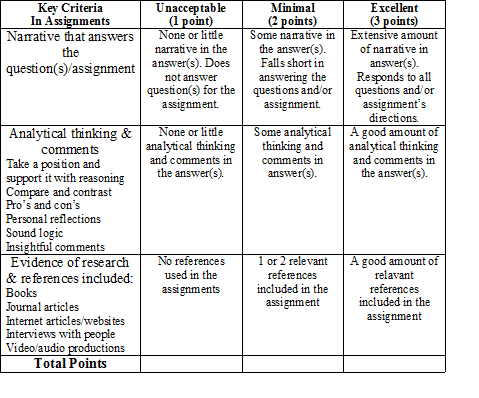| << Chapter < Page | Chapter >> Page > |
Research suggest that students may need additional guidance in an online course which does not meet in a traditional, face-to-face format. The NAR Rubric was specifically developed for online assignments in order to act as an instructional guide and also to provide constructive feedback to students. When students were asked “which learning activities were the most meaningful and helpful”, they identified the NAR Rubric above discussion boards, e-portfolios, videos, power-point presentation and several other learning activities.
Even though the NAR Rubric provides instructional guidance with online assignments, students perceive its greatest importance comes from the feedback provided by the instructor. This feedback comes in the form of fulfilling the three main components of the NAR Rubric: the narrative in addressing the assignment’s question(s), the inclusion of analytical reasoning, and the support of research and references with the assignment. Dereshiwsky (2001) agreed that properly designed web course assessment can produce more detailed feedback for students, more individual assessment of student’s work, greater student engagement, and a clearer direction in what is required with the assignments. Harasin, Hiltz,Teles, and Turoff (1996) in discussing online learning, stated “In keeping with a learner-centered approach, evaluation and assessment should be a part of the learning-teaching process, embedded in class activities and in the interactions between learners and between learners and teachers”.
The students perceive the NAR Rubric cultivates critical thinking and research with online assignments. Overall, the results indicate students conducted more research and more analytical work in the completion of assignments. The reason for this increase in these two learning outcomes is that the students seem to follow the NAR Rubric’s Analysis and Research criteria. Thus, a rubric can not only be a teacher/instructional tool, but a rubric is a learning tool ( Designing rubrics to fit assignments , 2010). Students should see rubrics as “red flags” that highlight the important components of a paper. Rubrics remind students what to watch out for, what to revise if necessary, and what will be considered in the assignment of the paper (Smithson, 2001). It seems many of the students recognize and appreciate the need to follow the three criteria of the NAR Rubric in order to achieve the expected learning outcomes.
The NAR Rubric became a major instrumental guide to their learning outcomes in the areas of research and analytical thinking. In the open-ended questions, one student commented there was definitely an emphasis in the readings and research with the assignments.
As online education continues to grow at a rapidly increasing pace, sound teaching and learning practices in these courses need to be implemented. It is important for faculty members to understand the best practices of online education and be cultivating the higher order thinking skills in this type of instructional environment. The NAR Rubric described in this paper was investigated by the author related to students’ perceptions of its effectiveness in online courses. Overall, the data from this study indicate that the rubric is a beneficial tool for students and their learning.
The NAR Rubric provides direction in completing online assignments. With no face-to-face classroom contact (in online courses) to introduce and/or thoroughly explain the assignments, the rubric becomes the guiding tool to work through the assignment and emphasizes the key components in the paper. These key components are: a comprehensive narrative that answers the assignment’s directions/questions; analytical comments and thoughts interwoven and supporting the narrative; and evidence of research and references embedded in the narrative. Students in this study felt their learning was enriched and expanded concerning research work to complete an assignment and the generation of critical thinking incorporated into the assignment. Contrary to some thinking, current online college courses are not alienating, lock-step programs. They are a labor-intensive and intellectually challenging forum which elicits deeper thinking on the part of the students and which present more individual communication between instructor and student.
Future research is encouraged to explore:
Faculty members teaching online courses may benefit from a review of the NAR Rubric found in this study. With the increasing number of courses going online, there needs to be “best practices” studied in order to aid instructors in optimizing learning outcomes. The NAR Rubric would provide this help and guidance for faculty when introducing and assessing assignments in online courses.
Appendix
Rubric to Evaluate Assignments


Notification Switch
Would you like to follow the 'Ncpea handbook of online instruction and programs in education leadership' conversation and receive update notifications?